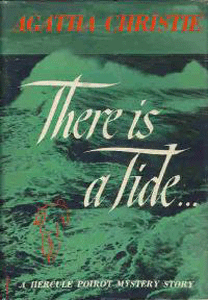“There is a Tide …” (1948, also published as “Taken at the Flood”) is one of those Agatha Christie novels where you close it and say “Yep, she’s the master at this stuff.” The reader and Poirot navigate a compelling mystery that uses false leads, twists and one obvious-in-retrospect clue. But it’s also an insightful character piece.
Where there’s a will there’s a murder
We start with the standard Christie structure: A large family in a quaint English village wades through controversy over the late patriarch’s will. Nonetheless, “Tide” stands out from the pack because several of these people stuck with me after the final page.
Christie mulls a certain type of young woman – one who craves danger rather than a stable life with a predictable man. Women like this are where the cliché that “nice guys finish last” comes from.

“There is a Tide …” (1948)
Also published as: “Taken at the Flood”
Author: Agatha Christie
Series: Hercule Poirot No. 29
Genres: Mystery, family drama
Setting: Warmsley Vale, England, 1946
Lynn Marchmont had always assumed she would marry Rowley Cloade, whose farm is near her house in Warmsley Vale. But, feeling she has changed since serving in WWII, she is drawn to criminally inclined cad David Hunter. He’s the literary equivalent of a scenery chewer, a somewhat rare Christie character who should not be played with English reserve in a screen translation.
David’s sister, newly rich widower Rosaleen, is also one of those drama-craving women, according to David’s explanation to Lynn in Chapter 4:
“She didn’t like Nigeria – and I don’t think she liked her husband much. If he’d been a hearty sort of fellow who drank and beat her, it would have been all right. But he was rather an intellectual man who kept a large library in the wilds, and who liked to talk metaphysics. So she drifted back to Capetown again.”
Plenty of motive to go around
Taking its title from a line in Shakespeare’s “Julius Caesar,” “Tide” has a deep cast of Cloades, all of whom who feel defrauded of their inheritances by Rosaleen, who had married their generous uncle.
I couldn’t keep all of them straight (that’s my one knock against this novel), but it doesn’t matter too much. The idea is that they all have motive to kill Rosaleen. Interestingly, though, Rosaleen is not the first murder victim.
“Tide” is structured like “Appointment with Death” (1938): We meet every member of this dysfunctional extended family in the first half, then Poirot enters in the second half.
Poirot is bothered that the case doesn’t have “the right shape.” His (and our) observations about people’s nature and behavior will be key to solving it as much as (if not more than) raw clues, which the author masterfully disperses. Christie is on her A-game with this mystery, and it’s a big reason why I rate “Tide” highly.

Uncomfortable truth
Another reason is her insight into personality types – among them a humorously proper old woman with a mustache whom even Poirot shrinks from.
I admit I spent some time reflecting on a certain character type, though. I was troubled that one woman ends up choosing a man who had tried to kill her. Not only that, but his murder attempt cinches her decision to marry him!
Arguably, this is a problematic piece of writing, glorifying a gross and unhealthy relationship. But I thought about it and decided Christie is portraying a type of woman who does exist in reality. The author should not be criticized for shining a light on an uncomfortable truth.
Besides, Christie makes it clear “There is a Tide …” isn’t a “happily ever after” story (something she’s guilty of in other final chapters). It’s a “happy, for now.” After all, tides roll both in and out.
Every week, Sleuthing Sunday reviews an Agatha Christie book or adaptation. Click here to visit our Agatha Christie Zone.

